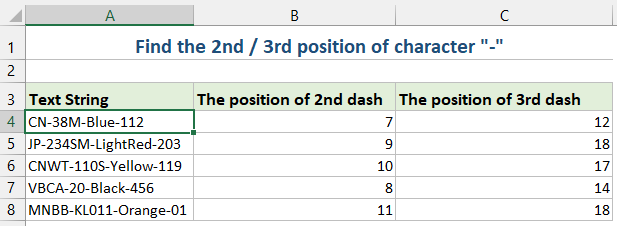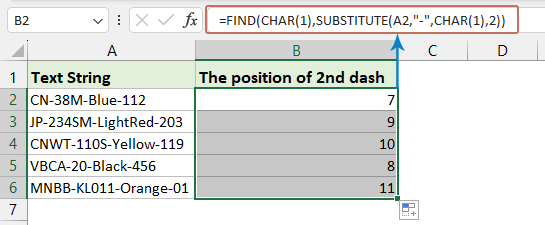Trova l'ennesima occorrenza di un carattere in Excel – 3 metodi rapidi
Trovare l'ennesima occorrenza di un determinato carattere all'interno di una stringa di testo in Excel può essere particolarmente utile nell'analisi dei dati, dove potrebbe essere necessario analizzare stringhe o estrarre informazioni basate su determinati delimitatori o schemi. Ad esempio, cerchiamo la seconda o terza occorrenza del carattere "-" in una stringa di testo. Dimostrerò tecniche semplici per svolgere questo compito in modo efficiente.

Trova l'ennesima occorrenza di un carattere in una stringa di testo con una formula
Puoi creare una formula per trovare l'ennesima occorrenza di un carattere. Procedi come segue:
1. Inserisci o copia la seguente formula in una cella dove desideri ottenere il risultato:
=FIND(CHAR(1),SUBSTITUTE(A2,"-",CHAR(1),2))- "A2": La cella che contiene la stringa.
- "-": Il carattere che stai cercando.
- "2": La seconda occorrenza che vuoi trovare, puoi cambiarla in 3, 4… a seconda delle tue esigenze.
2. Quindi, trascina la formula verso il basso per applicarla ad altre celle, e la posizione della seconda occorrenza del carattere "-" verrà visualizzata immediatamente, vedi screenshot:
- "SOSTITUISCI" sostituisce l'ennesima occorrenza del carattere con un carattere non stampabile (CARATT(1)).
- "TROVA" cerca questo carattere non stampabile, fornendo la posizione dell'ennesima occorrenza.
Trova l'ennesima occorrenza di un carattere in una stringa di testo con Kutools per Excel
Se non sei un fan dell'uso di formule o VBA, potresti considerare un'alternativa conveniente – "Kutools per Excel". All'interno dei suoi gruppi di formule, troverai un'utilità utile – "Trova la posizione dell'ennesima occorrenza di un carattere in una stringa", che identifica rapidamente e restituisce la posizione ennesima di qualsiasi carattere in una cella.
Dopo aver installato Kutools per Excel, clicca su "Kutools" > "Assistente formula" > "Assistente formula" per aprire la finestra di dialogo "Assistente formula". Clicca su una cella dove vuoi inserire il risultato. Poi, procedi come segue:
- Seleziona "Ricerca" dall'elenco a discesa della sezione "Tipo di formula";
- Scegli "Trova la posizione dell'ennesima occorrenza di un carattere in una stringa" nella sezione "Seleziona una formula";
- Seleziona la cella che contiene la stringa che utilizzi, quindi digita il carattere specificato e l'ennesima occorrenza nei campi di testo nella sezione "Inserimento argomento";
- Infine, clicca sul pulsante "OK" per ottenere il risultato.

Kutools per Excel - Potenzia Excel con oltre 300 strumenti essenziali. Goditi funzionalità AI gratuite per sempre! Ottienilo ora
Trova l'ennesima occorrenza di un carattere in una stringa di testo con una Funzione Definita dall'Utente
In questa sezione, esploreremo come creare e utilizzare una UDF per trovare l'ennesima occorrenza di un carattere in Excel, fornendo una guida passo-passo per aiutarti a ottimizzare la gestione dei dati.
- Tieni premuti i tasti "ALT" + "F11", e si aprirà la finestra "Microsoft Visual Basic for Applications".
- Clicca su "Inserisci" > "Modulo", e incolla la seguente macro nella finestra Modulo.
Function FindN(sFindWhat As String, _ sInputString As String, N As Integer) As Integer 'Updateby Extendoffice Dim J As Integer Application.Volatile FindN = 0 For J = 1 To N FindN = InStr(FindN + 1, sInputString, sFindWhat) If FindN = 0 Then Exit For Next End Function - Quindi, chiudi la finestra VBA. Torna al foglio di lavoro, inserisci la seguente formula in una cella, e poi trascina la maniglia di riempimento verso il basso per applicare la formula ad altre celle, vedi screenshot:
=FindN("-",A2,3)
- Conta il numero di occorrenze di una parola in una colonna
- Se hai una colonna di dati che include alcuni valori duplicati come mostrato nello screenshot qui sotto, e ora quello che vuoi fare è contare il numero di occorrenze di una parola specifica in questa colonna. Ora, con questo tutorial, ti presento alcuni trucchi per risolverlo rapidamente in Excel.
- Sostituisci i primi n caratteri o l'ennesima occorrenza di un carattere con un altro
- In Excel, di solito troviamo e sostituiamo una stringa con la funzione Trova e Sostituisci, ma se ti trovi in uno dei casi seguenti, la funzione Trova e Sostituisci non può aiutarti.
- Estrai l'ennesimo carattere da una stringa
- In generale, potresti voler estrarre una stringa dopo un carattere specifico, ma in questo caso voglio estrarre l'ennesimo carattere da una stringa come mostrato nello screenshot qui sotto.
- Estrai i primi/ultimi n caratteri da una stringa
- Ad esempio, c'è un elenco con stringhe lunghe in ogni cella, e vuoi estrarre solo i primi n caratteri da ogni stringa, come i primi 3 caratteri di ogni stringa, e ora puoi usare i seguenti metodi per risolverlo in Excel.
Articoli correlati:
I migliori strumenti per la produttività in Office
Potenzia le tue competenze in Excel con Kutools per Excel e sperimenta un'efficienza mai vista prima. Kutools per Excel offre oltre300 funzionalità avanzate per aumentare la produttività e farti risparmiare tempo. Clicca qui per ottenere la funzione di cui hai più bisogno...
Office Tab porta le schede su Office e rende il tuo lavoro molto più semplice
- Abilita la modifica e lettura a schede in Word, Excel, PowerPoint, Publisher, Access, Visio e Project.
- Apri e crea più documenti in nuove schede della stessa finestra invece che in nuove finestre.
- Aumenta la produttività del50% e riduce centinaia di clic del mouse ogni giorno!
Tutti gli add-in Kutools. Un solo programma di installazione
La suite Kutools for Office include add-in per Excel, Word, Outlook & PowerPoint più Office Tab Pro, ideale per i team che lavorano su più app di Office.
- Suite tutto-in-uno — Add-in per Excel, Word, Outlook & PowerPoint + Office Tab Pro
- Un solo programma di installazione, una sola licenza — configurazione in pochi minuti (pronto per MSI)
- Funzionano meglio insieme — produttività ottimizzata su tutte le app Office
- Prova completa30 giorni — nessuna registrazione, nessuna carta di credito
- Massimo risparmio — costa meno rispetto all’acquisto singolo degli add-in

